240 6th Street, Calumet, MI
Password: ihd1319
Story Two: The Italian Hall Disaster and Calumet Theater

We left in the early morning hours to investigate the Calumet Theater in Michigan’s Upper Peninsula. Kat and I would be going solo on this hunt and not joining another team. Certainly this was not the first investigation we would do on our own but was one of the more complex. There would be a lot of ground to cover for two people.
Lost in our thoughts, we were unusually quiet during the long road trip. Our somber mood wasn’t from the theater’s supposed cadre of spirited entertainers but rather the Italian Hall Disaster of December 24, 1913. Let’s go back in time to Calumet’s early days.
Calumet, then the village of Red Jacket, was a growing and prosperous community at the turn of the century with the world’s largest copper producing mine. Mine owners and the village were getting wealthier with each day. It got to a point where the municipal leaders felt the town deserved its own opera house. After all, what well-to-do city didn’t have one? In 1897 the Red Jacket Opera House was built over the municipal offices in the center of town. It quickly became the hub of activity.
With the city’s increasing wealth, town officials began to wonder if the opera house was grand enough. Work soon began on an expansion. When completed in 1900, the Calumet Opera House was one of Michigan’s most elegant theaters. It boasted many modern amenities such as heat, electrical lights and an impressive seating capacity of 1200.
While city leaders and mine owners enjoyed this beautiful theater and many other luxuries, the miners were struggling underground. There was a growing discontent over wages and working conditions.
These hard-working men earned half of what other miners were making across the country. The owners grew richer while the miners worked long hours in terrible conditions. Injury and death became an accepted part of the job.
The miners’ discontent opened the door, in 1908, for the West Federation of Miners (WFM) to come in and unionize the workers. This was the beginning of a growing dispute and anger between union workers, non-union workers, management and business leaders. Those opposed to the union were called The Alliance.
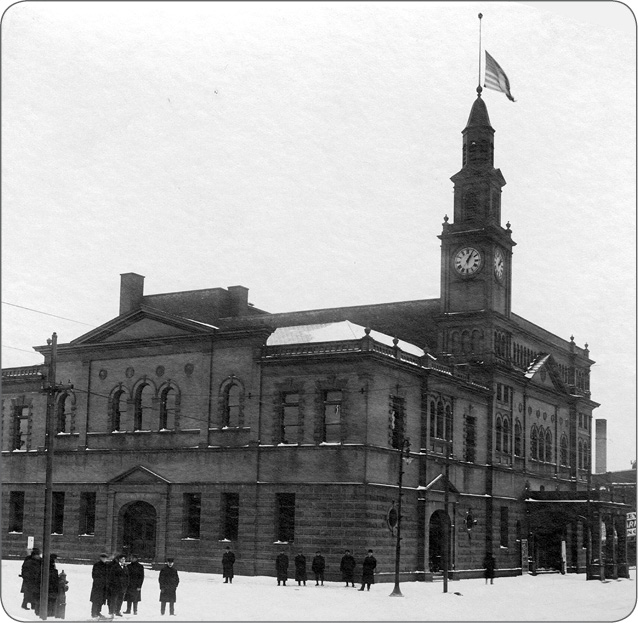
The original Calumet Theater/Red Jacket Opera House
MTU Archives and Copper Country Historical Collection,
Michigan Technological University
In the summer of 1913, union and management couldn’t agree on wage and labor issues. The union called a strike that idled over 15,000 workers. Miners thought the strike would end quickly, but they were wrong. Owners brought in non-union workers and by early December there still was no resolution in sight. Violence erupted that many believed was incited by The Citizens Alliance. Michigan’s Governor Ferris, concerned over the growing danger, decided to send in more than 2,600 National Guards to try and calm the city.
With constant fighting and lack of income, conditions were deteriorating for union workers and their families. Families were going without the bare necessities that included food and heat. With Christmas fast approaching, parents were afraid they wouldn’t be able to afford gifts and traditional festivities for their children.
Because of the dire situation, the Women’s Auxiliary decided to throw a Christmas party for the town’s children. Annie Clemec, known as Big Annie, was the Auxiliary president and coordinator of the event.
It was decided the party would be held at The Italian Hall, which served as the headquarters for Calumet’s Benevolent Society. At that time, Calumet was a melting pot of immigrants such as Finish, Polish, Italian, Croatian, Swedish and many others. The Society encouraged and provided financial aid to Calumet’s immigrant population. It also gave relief to victims of hardship. Many of the miners were new to the country, didn’t speak English, and needed help to adjust. So naturally, the Italian Hall would be the perfect site for the event.
It was early afternoon on Christmas Eve, 1913 when the crowd started to form. More than 600 people, mostly children, jammed in a room that should have held half that number. The hall was so full, people were crushed together. Some children fainted for lack of air. No one anticipated this kind of crowd.
The program that day was to include a play, caroling, candy and Christmas trees. The highlight would be when Santa came and gave all the children a gift.
As the afternoon progressed, the youngsters, in their eagerness, began to push towards the stage. Big Annie tried to control the children; but they were just too excited. It was decided to shorten the program. After leading a few carols, Santa arrived and began distributing gifts. That’s when the children excitedly rushed the stage. Annie called out that if they didn’t get back no one would get anything.
It was during this chaos that a man came up from the stairs and entered the room. No one paid attention until he yelled, “Fire … fire!” One of the parents, Mrs. Shiver, knowing there was no fire tried to quiet him down. He turned from her and was gone.
Mayhem instantly broke out. The cry of fire exploded across the hall. Pushing through the panic-driven crowds, frantic parents rushed to find their children. Others charged the single staircase in a desperate effort to get out.
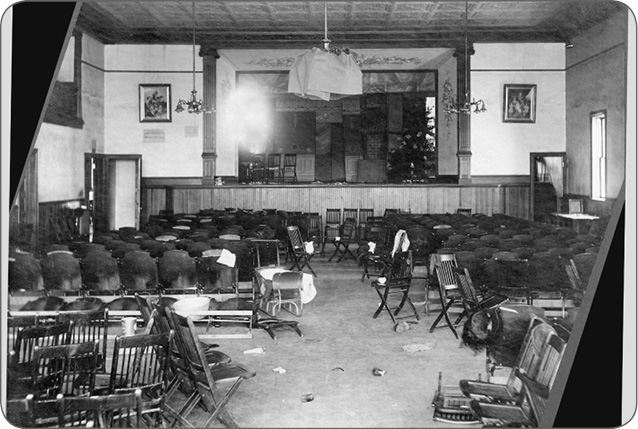
Over 600 children and their families crowded this small area.
The photo was taken the day after.
MTU Archives and Copper Country Historical
Collection, Michigan Technological University
Big Annie tried to reassure the crowd without success. Mrs. Shiver began to play the piano hoping the music would calm the people, but their fear was uncontrollable. Cries and screams were heard as scores tumbled down the stairs and were crushed by those tripping over them
The shrieks and wails of the living were mingled with the screams of the dying. The whole mass turned and lifted in a struggle to exit the stairway. Bodies piled upon bodies extending 30 feet up the staircase and nearly reaching the ceiling. Those that remained alive couldn’t move and were barely able to breathe. Most suffocated while others were crushed to death. In their crazed state, few thought of using the fire escape to reach safety.
Within minutes, Second Assistant Chief, Jacob Kaiser, arrived on the scene. This is where the eyewitness accounts become confusing. Some reports indicated rescuers couldn’t open the front door to assist the people because bodies blocked the door.
Yet other witness accounts indicated that rescuers opened the doors but couldn’t remove the bodies because of the horrific tangle of human limbs. Looking at the huge mass on the stairs it was hard to tell where one body ended and another began.
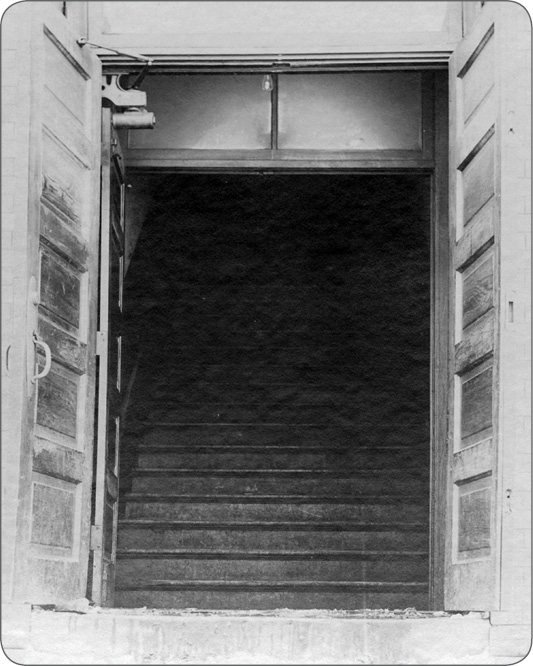
The stairs where 74 people, mostly children, lost their lives.
Bodies were stacked to the ceiling.
MTU Archives and Copper Country Historical Collection,
Michigan Technological University
Regardless of the reason, Kaiser and others rushed up the fire escape to the second floor. They were met with sheer chaos and had to claw their way to the staircase. Men, women and children ran about the room screaming while others continued to rush down the stairs to their death. In an attempt to gain control and calm the panic, in a loud booming voice Kaiser called for the people to settle down. There was no danger. The rescue party began untangling the living, injured and dead. It seemed to take an eternity.
The deceased were laid out in front of the Italian Hall where an already huge, frenzied crowd was waiting to see what had happened to their children. Emotion gripped those searching for their loved ones. Some parents, in their haste and grief, rushed their lifeless little one home only to later realize the child was not theirs.
It was obvious to the rescue team that leaving the dead outside was making things much worse. The decision was made to use the Red Jacket Opera House as a temporary morgue. The hall, normally filled with music and laughter, was soon filled with the bodies of innocent children, women and men and the tears of hopeless people. In the end, 74 lost their lives, 56 were children.
Sometime during that dreadful night, a photographer took a picture of the youngest victims laid on the stage. When the film was developed, the photographer noticed an unusual glow surrounding the bodies of the children. The picture was simply titled “Angels”. This photograph gained national recognition. After that, the people of Calumet and across the nation used the word “angels” when they spoke of the innocent children lost on that terrible Christmas Eve.
It was a dark and bleak Christmas in Calumet.
A mass funeral was arranged for the majority of the dead. It would take several days to prepare. The Western Federation of Miners covered the cost of burial, but it took time to raise the funds. More importantly, there were not enough caskets in the area and families had to wait for coffins to be brought in from other towns. The funeral was December 29, 1913.
All of Calumet was in mourning that day. Bells tolled as funeral services were held throughout the city. Tens of thousands came to mourn. The supply of hearses and vehicles was inadequate, so scores of union members carried the white coffins holding children.
Cold winds cut through the long procession of mourners as they slowly made their way across the frozen ground to the snow-shrouded cemetery not far from Lake Superior. The funeral procession extended for blocks.
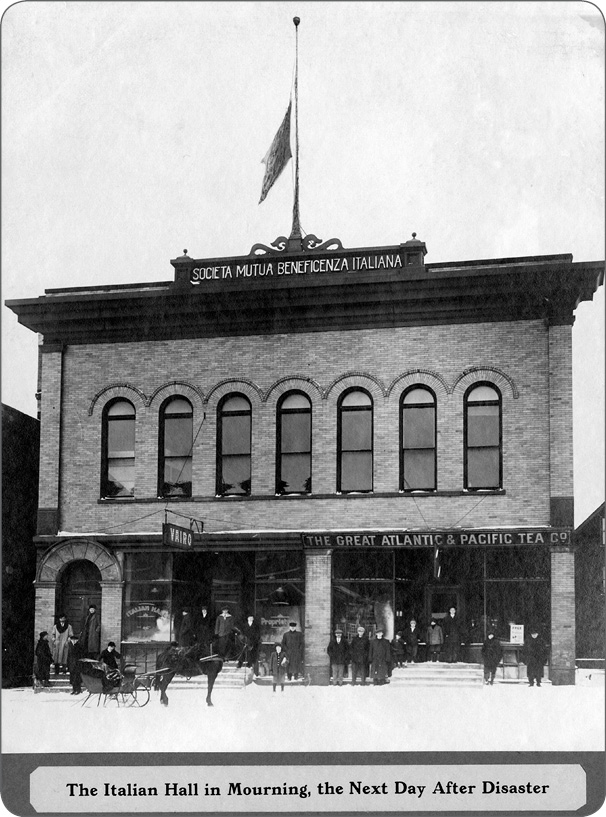
On Christmas Day people stood in the snow mourning the town’s loss.
MTU Archives and Copper Country Historical Collection,
Michigan Technological University
Once the dead were laid to rest the search for the guilty began. Inquest testimony was clouded. A few people thought the man who yelled fire was wearing an Alliance button and others disagreed. Adding to that, no one recognized the man. There were also conflicting statements about what he looked like and wore.
Blame was thrown back and forth. To this day the man remains unidentified and the reason for his actions a mystery. Eventually the strike was resolved, but the town would never be the same, nor would the union.
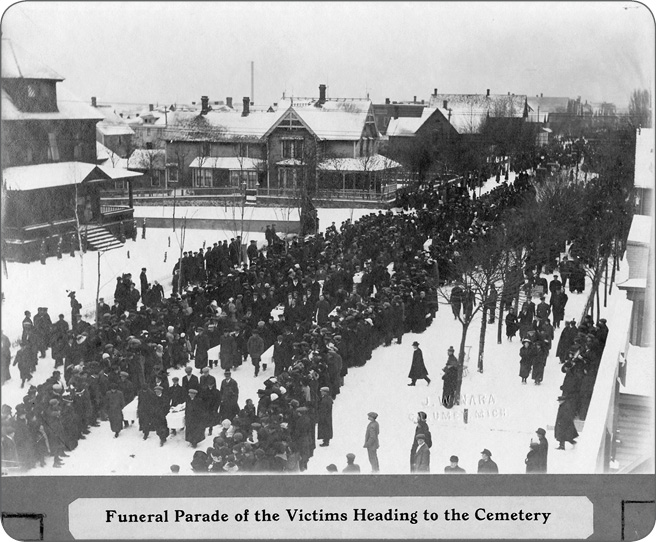
Thousands followed the funeral procession.
MTU Archives and Copper Country Historical Collection,
Michigan Technological University
Over the decades, as copper mining in Calumet declined so did the city’s wealth and population. Today Calumet’s population hovers around 1,000 residents, far less than its 25,000 during the city’s copper mining heyday.
It was late afternoon as Kat and I entered this historic town, our thoughts swinging back to the present. I slowly drove the car passed vacant lots and quiet streets. Calumet was almost a ghost town compared to its bustling days as the copper mining capital of the world. Glimpses of its former glory could still be seen in some of its remaining architecture.
Driving through the town what we failed to notice, in passing, was a small lot with a lonely, sandstone arch. Its significance was completely lost to us. We would later learn that this marked the location of the Italian Hall and was the sole reminder of that fateful Christmas Eve nearly one hundred years ago.
Traffic increased as we neared the Calumet Theater. With copper prominently displayed in its roof and cornices, this two-story renaissance revival structure clearly stood out from many of the other buildings in town. It immediately caught our eye as we turned onto 6th Street.
Laura Miller, Executive Director, greeted us at the theater’s main entrance. We asked her if traffic was always this busy around the theater and she chuckled, “The Theater always has something going on.”
Entering the main auditorium, we paused as our eyes scanned the amazing interior of this magnificent, historic theater. In our travels, we have been to many grand theaters and opera houses. The Calumet Theater ranks among the most impressive. Hand painted murals and gold inlays sweep up to curved, vaulted ceilings. Rows of seats lined the expansive room and upper balconies. Private booths peak from corners near the stage, each holding two white wicker chairs.
Its historic elegance has been meticulously restored by the non-profit Calumet Theater Company. This company leases the theater from the city. It is the only theater in the country that was and still is municipally owned. Financial support from the community and grants are used to maintain this historic theater.
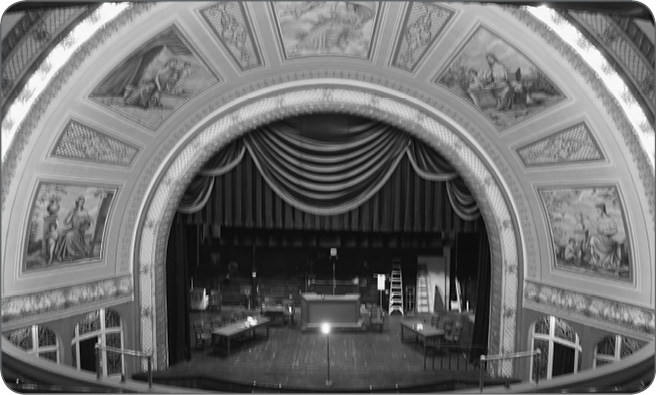
The opulent stage indicates the former wealth of Calumet.
Moving into the auditorium actors were rehearsing on stage for the upcoming play, Death of a Salesman. With a finger to her lips, so as not to disturb the actors, she ushered us into her office. Waiting inside was her friend Art. They would be our guides for the evening.
As we talked Laura explained she has been with the Calumet Theater for some time. She loves its history and beauty along with the creative energy of the performances. She is heavily involved with the Friends of Calumet Theater fundraising group dedicated to preserving its beauty and history.
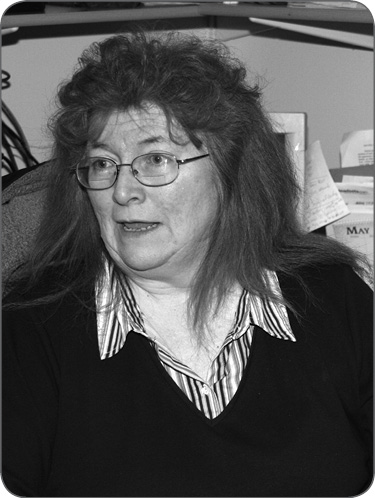
Laura Miller, Executive Director
responsible for much of the work
and fundraising necessary
to maintain the theater.
Laura began telling us about the theater and some of its ghostly stories. Over the years there have been many tales from patrons, workers and volunteers.
The first encounter with the paranormal involved the theater’s marketing director. It happened one afternoon just after a group of students from the high school left the theater. The art director was on stage and glanced towards the balcony. He saw a figure go by. Thinking it was one of the students, he went up to the balcony but no one was there. This happened to him once more when he was with another person. This time they both saw the figure.
The apparition of a man has been seen in the basement and people have felt cold spots. No one knows who the man is or why he remains.
People also hear music in the theater. The apparition of a woman in a beautiful formal gown is frequently seen and heard. We asked Laura who she thought the woman was. Without hesitation she responded, “Madame Modjeska.”
Helena Opid was born in Krakow, Poland in 1840. She would eventually marry her guardian, actor Gustave Sianmier, and took his stage name, Modrzejewska, eventually shortened to Modjeska.
Helena was a world-renowned Shakespearean actress who spent much of her later years performing in the United Sates and resided in California. She came to the Calumet Theater on three separate occasions.
Laura explained, “She was very fond of the Calumet Theater.”
In surprise I mention, “But she was only here three times.”
Laura explained why Madame Modjeska was here. She always wanted to play the female lead, Kate, in Taming of the Shrew but never had the opportunity. In the 1950s Taming of the Shrew was being performed at the theater. Actress Adysse Lane was the lead female and unfortunately forgot her lines in one scene. Laura said, “Her spirit (Madame Modjeska) was there, and when Adysse lost her lines Madame supposedly mouthed the words (to Adysse).”
Since then many people claim to have seen and heard Madame. It is said she becomes particularly annoyed when her beautifully framed picture is moved. This picture is on the back wall of the auditorium and a favorite of photographers. Laura mentioned that very frequently the photographer’s camera freezes, the battery is drained or the picture doesn’t come out.
When speaking of the paranormal activity at the Calumet Theater, she talked about Kathy Lynch. Kathy is the founder of G.H.O.S.T. Paranormal Society in the Upper Peninsula. Her team has investigated the theater on several occasions. Laura mentioned that her and Kathy along with other team members had experiences during investigations. The result of those investigations were a number of EVPs. We were looking forward to hearing them at a later time.
What peaked our attention was listening to Laura recount the paranormal activity in the ballroom. This section of the theater was the original Red Jacket Opera House. Many of the EVPs from G.H.O.S.T. were actually collected here.
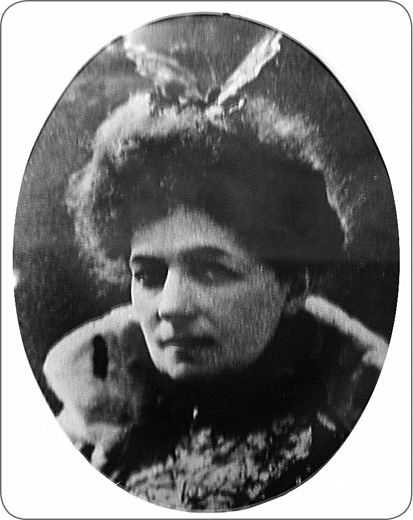
Madam Modjeska is said to haunt the theater.
Laura told the story of one particular investigation with G.H.O.S.T. in the ballroom. Five of them sat at a table leaving one empty chair. Kathy began talking to the spirits, “Is there any one here? Could you give us a sign? Please sit down and join us.”
Suddenly the two investigators sitting on either side of the vacant chair felt a sudden chill emanating from the empty seat. Laura said the temperature dropped about 30 degrees and stayed that way for a few minutes. According to Laura, after reviewing audio, Kathy captured several distinct EVPs.
Kat and I were eager to start the investigation. After concluding the tour with Laura and Art, we laid out our plans. With just two IR video cameras and three digital audio recorders, positioning was critical. Since most of the activity occurred in the auditorium and ballroom, those would be our areas of focus. One camera would stay with us. The second was positioned on the stage viewing the auditorium and balconies, where reported apparitions have been seen.
One audio recorder was placed on the second balcony, another in the auditorium and the third in the ballroom. An IR video camera stationed on the stage would serve as a fourth audio device and capture any movement in the auditorium’s main floor and balconies. A second IR video camera, two digital still cameras, an EMF meter and thermo gage would stay with us.
Over the decades there have been many reports of paranormal activity. We now wondered, with anticipation, if we could confirm stories of the Calumet Theater’s haunting. The investigation began.
Laura asked if we wanted the lights turned off. For many paranormal teams, that is the only way they investigate. Kat and I believe there are benefits to that. We also believe there are benefits to investigating by recreating the conditions in which paranormal activity is experienced. Since apparitions were seen in the main auditorium with the lights partly on, that’s the condition we wanted for the auditorium. During the night regular EMF and temperature readings would be taken to establish base readings and help identify unusual spikes that might indicate activity during the evening.
Gathering in the auditorium, Kat took a position on stage bringing an EMF meter. I sat in the first row with a thermo gage. Laura and Art were in the back.
Kat started by calling out Madam’s name, asking if she would respond with a knock. Several minutes pasted in silence. Then Kat asked if the spirit of someone from the Calumet Theater was with us. She called for any performers to come forward. There was no noticeable response.
An attempt to recreate an event or talk about something familiar to the spirit’s past is frequently used to draw them out. This would be our next approach.
I asked Laura to talk about the early days of the theater and she told us about the first performance in March 1900. It was the comedy, The Highway Men. As Laura began talking about Madam Modjeska and her fame as an actress, Kat noticed EMF levels began to rise. She encouraged Laura to continue.
It was at that point Kat asked Art if he thought Madam Modjeska was beautiful. Art said, “No, not really.” Kat glanced at the EMF and laughed, “I don’t know if she’s with us… but the EMF went down to zero.” At the same time Kat felt coolness and noticed a sudden temperature drop from 62 to 57 degrees. Was it paranormal of just the chill of the night setting in?
Kat asked if some of the famous people who had performed in the theater were there, such as Sara Barnhart and Lon Chaney. Again, no response.
We thought the performers might need a little encouragement to come out. Everyone gave them a big round of applause, but if there were spirits around they continued to be elusive.
The investigation would now move to the upper balconies. We settled on the second floor balcony, where the marketing director had seen a shadow on two separate occasions.
This shadowy vision may have simply been a trick of the eye, but maybe not. The Red Jacket Ballroom, which served as a temporary morgue after the panic, can be entered from this level. We wondered, if there really was a shadow, could it be a lost soul from 1913?
Kat put the EMF meter on the floor as we began asking questions. Approximately 30 minutes into our session we began noticing slight EMF fluctuations. At first, neither Kat nor I paid much attention until we realized these minor changes correlated directly to questions about children.
Kat asked if the spirit was that of an adult male or female. EMF remained flat. When asked if it was a little girl, EMF remained flat. EMF began to move when Kat’s questions centered around a little boy.
“Were you a little boy between the ages of six and eight?” The EMF ticked upward. We looked at each other with growing anticipation. Was it a response?
“Were you younger than six? Were you five?”
The EMF dropped to zero.
Kat resumed her upward age count, but the EMF remained flat.
“Were you at the Italian Hall December 24th?” In silence we watched as the EMF levels once again elevated.
Laura asked, “Were you here to watch movies? There were lots of movies.” EMF immediately dropped to zero.
Levels remained flat through a series of questions. It seemed If anything had been with us, it was now gone. We decided to move to the next location.
Just after 1:00 a.m. we entered the ballroom. Moonlight cast a ghostly pallor across the stage that once held the bodies of victims from that Christmas Eve so long ago. There was a certain chill that went beyond the coolness of the room. None of us today could possibly understand the horror and pain that occurred in this place now so quite and still.
Laura pointed to a table in the center of the room. This is where Kathy and her team had collected evidence on a prior investigation. We chose the same location in an attempt to recreate a similar environment. An audio recorder was placed on the table.
There is no denying that we felt a change, heaviness in the atmosphere. In the dark Kat began to set up her video recorder. I told the spirits to wait, “Don’t show yourself until the camera’s ready.”
Kat responded, “Oh, that they should be so kind.” A whispered response remained unheard.
Our EVP session began in earnest when Laura invited the spirits to join us. Silence followed.
Then I said, “Who are you?” Again silence.
We sat quietly. Seconds drifted into minutes as time passed.
Eventually, Laura pointed to an upper balcony where band or orchestra members used to play. She explained that strange lights had been seen in that area. Noting windows faced the street, we thought perhaps it might be passing reflections from car lights. Not long after, a car did pass by and its lights did reflect on the wall. This identified a possible reason.
We resumed to our silent vigil until Kat’s next question, “Were you part of the Italian Hall Panic? Did you lose someone? Did you die?”
For a moment nothing, and then a faint sound, a whisper. It was none of us. Just our imagination? Only later would we know.
EMF and temperature were checked. Kat was about to tell us the EMF had spiked but halted in mid sentence. “I think I just saw a shadow back there. Right against the window,” she whispered. Immediately vigilant, our eyes turned toward the window. Nothing. Laura commented this had been a very active area on the last investigation.
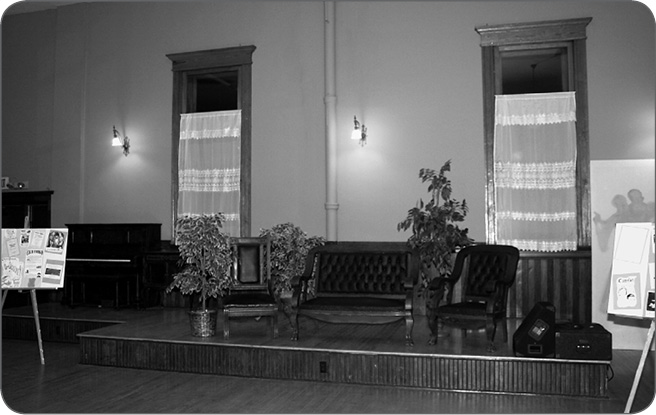
Stage, Red Jacket Opera House.
Location where many bodies were placed after the Italian Hall Disaster.
Taking the EMF meter from the table, Kat moved to the stage. Everything was normal. The video camera was pointed in that direction. If there had been a shadow, it would be captured.
There was a sense among us that something was waiting to happen. It was about 1:45 a.m. Activity seemed to be rising. I heard something. A whisper. I asked if anyone else heard it. They hadn’t.
This is the challenging part of investigations. There is always some point when your eyes and ears begin playing tricks. Is that what was happening to us? Sometimes it is only in evidence review when you find the truth.
If there was spirit activity here, we hoped to stir it up by recounting the tragic events of December 24, 1913. At that point in our conversation, Kat called out, “Is the person who yelled fire at the Italian Hall Disaster with us tonight? Are you a coward?”
Time continued to slip away. Shortly after 2:30 a.m., we decided to call it a wrap. Laura, Art, Kat and I were exhausted. Thanking them for their help, we packed our equipment and headed off for some much needed rest. All of us hoped something had been recorded that evening.
The outside air was cool and damp. Streetlights cast a sickly yellow pallor over the empty streets. It is a time of night when some say only the dead are alive. How true those words seemed to us now.
Earlier in the evening Laura told us where the Italian Hall memorial was located. Driving down the road, we turned the corner and stopped at the memorial site. It seemed the whole city was asleep but us. Moonlight reflected off the archway and lonely bronze marker on this tiny plot of land. Impossible. Impossible to imagine this small lot was the site of the Italian Hall and Calumet’s most horrible disaster.
The chill cut right through us was we walked under the arch and entered hallowed grounds. Our time here lasted only 10 minutes. Exhausted, the motel seemed an eternity away.
Over breakfast the next morning, we discovered the Italian Hall audio file was blank. The decision was made to return to the site. Unintentionally, we arrived about the same time the families arrived that fateful Christmas Eve in 1913. This time Kat and I came prepared with two audio recorders, camera and video recorder. The cluster of small homes lining the streets near the memorial site were quiet.
A few questions were asked, but mostly we just sat and listened. The only sound heard was the wind swirling around the leafless tree. Thirty minutes later, we gathered our equipment and left. We never looked back.
Driving up to Calumet had been a quiet and pensive time for us. That was not the case going back. We chatted nearly non-stop and somehow made the eleven-hour drive in about nine.
We expected to begin reviewing recorded materials shortly after returning. Unfortunately, our business kicked into high gear. As weeks passed, Kat and I seemed to forget about the events that transpired the night of our Calumet investigation. It quickly came back as we began reviewing video, audio and photographs. The evidence collected that evening and following day could not have been anticipated.
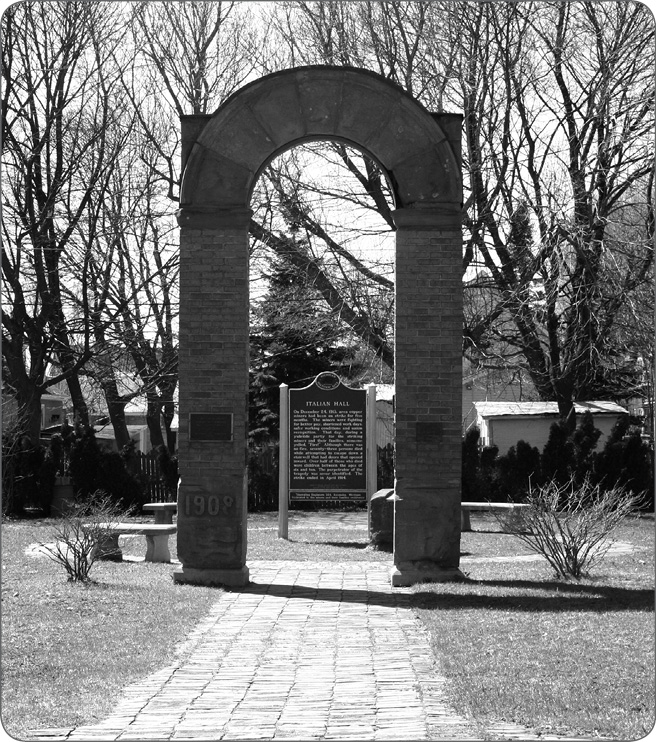
The original Italian Hall arch
and this small memorial are the only reminders of that fateful day .
Let’s return to the night’s chain of events. The investigation began on the first floor. Kat was on the stage and I was in the first row. Laura and Art sat in back. We started talking about Madam Modjeska. Kat noticed the EMF levels began to elevate and she felt a cold spot. Kat asked Art if he thought Madam was beautiful. He casually replied, “No not really.” Moments later our audio picked up a voice. We believe in may say “Modjeska.” It’s a little odd because it appears to be Madam’s name but ending in an “o” (Modjesko). Could the stories of Madam’s spirit remaining be true?
Our time in the balcony also had its surprises.
Headphones in place, Kat and I were listening to audio in our respective offices when I felt a tap on my shoulder. I looked up to see her pointing to her office and followed as she disappeared around the corner.
She sat quietly sitting at the computer holding out headphones as I entered. “We got a response,” was all she said.
I positioned the earphones, as Kat began the audio clip. We were on the second balcony. EMF levels were fluctuating. I heard Kat’s voice ask if the spirit was a boy between the age of 6 and 8. The audio hissed white noise for a moment, then a long, drawn out response, “Yes.” Shortly after, I can hear Kat’s voice saying EMF levels had risen.
I glanced at Kat. She nodded, “There’s more.”
The next audio clip was played. The sound of Kat’s voice was heard asking if the boy was 10, 11 or 12. The hushed voice again responded. This time the word I heard was, “No.”
Yet another clip was played. “Were you at the Italian Hall Panic?” Kat asked. Several second passed with only the empty sound of white noise. I looked up thinking I had missed the EVP. I saw Kat mouth the word, “Wait.” It was then I heard it, the long, drawn out response, “Yeees.” Followed by Kat’s voice saying EMF levels had risen.
It seemed there was someone on the balcony with us that night. But who it was remains a mystery. It was particularly strange that the voice sounded more like an adult male than a young boy. If we ever return for another investigation, we will certainly expand our questioning to hopefully learn more.
Verbal responses weren’t the only things captured on audio. Additional sounds were recorded after we left the balcony. One thing heard was unusual music, much like what you would expect to hear at a silent movie, or from a gramophone. This lasted for several minutes. It had a tinny, disjointed sound. We don’t know its cause and after Laura reviewed the sound she had no idea where it came from but Laura did tell us the marketing director often heard music in the auditorium. Perhaps this is what he hears.
While Kat continued to review her audio, I loaded the segment from the ballroom into my computer. After getting so many unexpected EVPs in the theater, I was anxious to review the audio from the ballroom, the original Red Jacket Opera House. If spirits or their energy remain anywhere within these walls, it seems they would be in the ballroom. After all, this room was the culmination of the towns biggest tragedy.
I would not be disappointed. The first recording came at 12:05 a.m., just minutes after we left the recorder in the room. It was a single, mournful word, “Angel.” As the hushed voice came through the headphone, I had to fight back a sudden sense of remorse. Through research and reading eyewitness accounts, we had learned the dead children were often referred to as Angels.
At 12:23 a.m. another disembodied voice was captured. Again it was a single word, “Annie.” Was the voice calling out to Big Annie, Anna Clemec the Auxiliary President who had arranged the Christmas Eve party? Big Annie desperately attempted to calm everyone during the panic. Could someone be calling out to her even now?
Another EVP was captured shortly after 1:00 a.m. The four of us had entered the ballroom and Kat began to set up her camera. At that point I remarked, “We’d love to talk to you. Don’t show yourself until the camera’s up.” The very obliging response was, “Happy to.”
Time slipped away as I eagerly continued the ballroom audio. I heard Kat ask if there was anyone with us from the panic and if they died. A few seconds later, the soft hiss of “yes” was recorded.
Unfortunately the shadow Kat thought she’d seen against the ballroom window was not seen on video. It was dismissed as a common problem with ghost hunting, seeing things in the dark that simply aren’t there. We believed that until, just moments after Kat thought she saw a shadow, a voice was heard, “Hope they get it.” The voice sounded as if it spoke directly into the recorder. Is it possible that at least one spirit is hoping the shadow was captured on video? To this day we wonder why.
Having finished her audio review, Kat came into my office and sat down. “So, what are you finding?”
“More than we would have expected,” was my response.
After listening to the evidence I had turned up, we sat down together to finish the ballroom audio.
Other EVPs were captured in the ballroom including the voice of a child, a woman and a voice speaking over our conversation. There are different interpretations of what they’re saying. These EVPs can be heard in our Secret Room.
It was near the end of our time in the ballroom, the last few minutes of time code clicked away. It’s then one of the strongest EVPs was captured. Kat asked if the person who yelled fire at the Italian Hall was a coward.
We heard nothing that night sitting in the dark. It seems we were wrong. But then we’ve come to learn so much in the paranormal eludes our natural and limited senses. On audio the response was clear as was its message. A lifeless, male voice repeated, “Coward.”
As the last moments of audio faded, we sat there stunned at the amount of evidence captured. Kat and I have been on over 100 investigations since we began writing about our ghost hunting experiences. We both agree this ranks as one of our top paranormal locations. It is very possible that the Calumet Theater has both residual and intelligent spirits residing within its walls.
The evidence doesn’t end here. Perhaps the most profoundly touching EVPs were collected during our brief time at the Italian Hall Memorial Site. There were just three little words, but they were profoundly touching, “Momma” and “Johnny … Johnny?” Several children named Johnny died on December 24, 1913. Was this one of them? We pause, as this story ends and wonder, did they ever find each other?